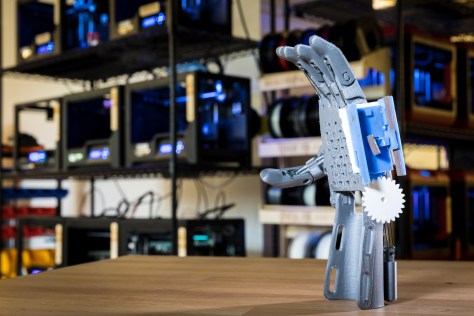Encore: 3D printed attachments
What happens when you want to 3D print something that must interact with the real world? The Encore project makes it possible to 3D print objects that must attach to things in the real world. Encore provides an interface that, given an imported object and a chosen attachment method, visualizes metrics relating the goodness of the attachment. In addition, once an attachment type and location is chosen, Encore helps to produce the necessary support structure for attachment. Encore supports three main types of attachment: print-over, print-to-affix, and print-through.
Print-Over
Print-over attachments are printed directly on the existing object. This works well if the object is flat enough that the print head won’t encounter obstacles as it moves, and the object is made of a material that the printed material will easily adhere to. Encore helps by finding a rotation of the existing object that minimizes obstacles, and generating support material to hold the existing object in place.
 |
 |
|
Printing a magnet holder over a Teddy bear toy.
|
 |
 |
|
Left: printing an LED casing on a battery to make a simple torch; right: printing a handle to an espresso cup.
|
Print-to-Affix
An alternative that is useful when the existing object does not fit on the print bed is print-to-affix. In this approach, the attachment is designed to fit snugly against the existing object. It may be glued in place, or can include holes for a strap, such as a zip tie.
 |
 |
|
Left: printing a structure to make a glue gun stand; right: printing a reusable four-pack holder.
|
Print-Through
Finally, sometimes the attachment should be interlocked more loosely with the existing object. In this case, the process is to begin printing and stop the print partway through so that the existing object can be inserted. Encore can compute when this stopping point should be (and
whether it is possible)
 |
 |
|
A name tag printed through a pair of scissors
|
 |
 |
|
A bracelet printed through a charm
|
Encore the Design Tool
Encore is implemented in WebGL. It supports importation of an existing object, selection of an attachment, and then lets the user click to indicate where the attachment will go. Given this information, it uses geometric analysis to compute metrics for goodness of attachment, such as attachability and strength. Encore visualizes them using a heat map so that the user can adjust the attachment point.

Encore visualizes which parts of a wrench are more attachable when printing over a handle.
More Examples

Using print-to-affix to make a trophy from an egg holder
|

Using print-over to make a minion keychain
|

Using print-over to add a hanger to a screwdriver handle
|

Using print-through to make a key ring.
|

Using print-to-affix to make a battery case
|
|











 The absence of tactile cues such as keys and buttons makes touchscreens difficult to navigate for people with visual impairments. Increasing tactile feedback and tangible interaction on touchscreens can improve their accessibility. However, prior solutions have either required hardware customization or provided limited functionality with static overlays. In addition, the investigation of tactile solutions for large touchscreens may not address the challenges on mobile devices. We therefore present Interactiles, a low-cost, portable, and unpowered system that enhances tactile interaction on Android touchscreen phones. Interactiles consists of 3D-printed hardware interfaces and software that maps interaction with that hardware to manipulation of a mobile app. The system is compatible with the built-in screen reader without requiring modification of existing mobile apps. We describe the design and implementation of Interactiles, and we evaluate its improvement in task performance and the user experience it enables with people who are blind or have low vision.
The absence of tactile cues such as keys and buttons makes touchscreens difficult to navigate for people with visual impairments. Increasing tactile feedback and tangible interaction on touchscreens can improve their accessibility. However, prior solutions have either required hardware customization or provided limited functionality with static overlays. In addition, the investigation of tactile solutions for large touchscreens may not address the challenges on mobile devices. We therefore present Interactiles, a low-cost, portable, and unpowered system that enhances tactile interaction on Android touchscreen phones. Interactiles consists of 3D-printed hardware interfaces and software that maps interaction with that hardware to manipulation of a mobile app. The system is compatible with the built-in screen reader without requiring modification of existing mobile apps. We describe the design and implementation of Interactiles, and we evaluate its improvement in task performance and the user experience it enables with people who are blind or have low vision.




 A variety of 3D-printed upper-limb assistive technology devices designed and produced by volunteers in the e-NABLE community. Photos were taken by the fourth author in the e-NABLE lab on RIT’s campus.
A variety of 3D-printed upper-limb assistive technology devices designed and produced by volunteers in the e-NABLE community. Photos were taken by the fourth author in the e-NABLE lab on RIT’s campus.




















